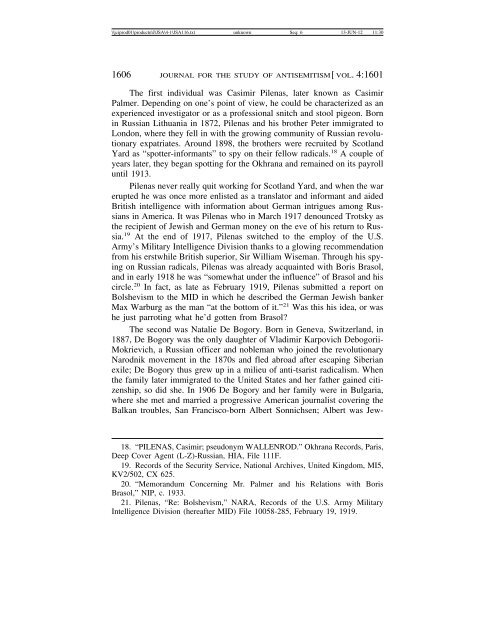The Tsar's Other Lieutenant: The Antisemitic Activities of Boris L ...
The Tsar's Other Lieutenant: The Antisemitic Activities of Boris L ...
The Tsar's Other Lieutenant: The Antisemitic Activities of Boris L ...
Create successful ePaper yourself
Turn your PDF publications into a flip-book with our unique Google optimized e-Paper software.
\\jciprod01\productn\J\JSA\4-1\JSA116.txt unknown Seq: 6 13-JUN-12 11:30<br />
1606 JOURNAL FOR THE STUDY OF ANTISEMITISM[ VOL. 4:1601<br />
<strong>The</strong> first individual was Casimir Pilenas, later known as Casimir<br />
Palmer. Depending on one’s point <strong>of</strong> view, he could be characterized as an<br />
experienced investigator or as a pr<strong>of</strong>essional snitch and stool pigeon. Born<br />
in Russian Lithuania in 1872, Pilenas and his brother Peter immigrated to<br />
London, where they fell in with the growing community <strong>of</strong> Russian revolutionary<br />
expatriates. Around 1898, the brothers were recruited by Scotland<br />
Yard as “spotter-informants” to spy on their fellow radicals. 18 A couple <strong>of</strong><br />
years later, they began spotting for the Okhrana and remained on its payroll<br />
until 1913.<br />
Pilenas never really quit working for Scotland Yard, and when the war<br />
erupted he was once more enlisted as a translator and informant and aided<br />
British intelligence with information about German intrigues among Russians<br />
in America. It was Pilenas who in March 1917 denounced Trotsky as<br />
the recipient <strong>of</strong> Jewish and German money on the eve <strong>of</strong> his return to Russia.<br />
19 At the end <strong>of</strong> 1917, Pilenas switched to the employ <strong>of</strong> the U.S.<br />
Army’s Military Intelligence Division thanks to a glowing recommendation<br />
from his erstwhile British superior, Sir William Wiseman. Through his spying<br />
on Russian radicals, Pilenas was already acquainted with <strong>Boris</strong> Brasol,<br />
and in early 1918 he was “somewhat under the influence” <strong>of</strong> Brasol and his<br />
circle. 20 In fact, as late as February 1919, Pilenas submitted a report on<br />
Bolshevism to the MID in which he described the German Jewish banker<br />
Max Warburg as the man “at the bottom <strong>of</strong> it.” 21 Was this his idea, or was<br />
he just parroting what he’d gotten from Brasol?<br />
<strong>The</strong> second was Natalie De Bogory. Born in Geneva, Switzerland, in<br />
1887, De Bogory was the only daughter <strong>of</strong> Vladimir Karpovich Debogorii-<br />
Mokrievich, a Russian <strong>of</strong>ficer and nobleman who joined the revolutionary<br />
Narodnik movement in the 1870s and fled abroad after escaping Siberian<br />
exile; De Bogory thus grew up in a milieu <strong>of</strong> anti-tsarist radicalism. When<br />
the family later immigrated to the United States and her father gained citizenship,<br />
so did she. In 1906 De Bogory and her family were in Bulgaria,<br />
where she met and married a progressive American journalist covering the<br />
Balkan troubles, San Francisco-born Albert Sonnichsen; Albert was Jew-<br />
18. “PILENAS, Casimir; pseudonym WALLENROD.” Okhrana Records, Paris,<br />
Deep Cover Agent (L-Z)-Russian, HIA, File 111F.<br />
19. Records <strong>of</strong> the Security Service, National Archives, United Kingdom, MI5,<br />
KV2/502, CX 625.<br />
20. “Memorandum Concerning Mr. Palmer and his Relations with <strong>Boris</strong><br />
Brasol,” NIP, c. 1933.<br />
21. Pilenas, “Re: Bolshevism,” NARA, Records <strong>of</strong> the U.S. Army Military<br />
Intelligence Division (hereafter MID) File 10058-285, February 19, 1919.














